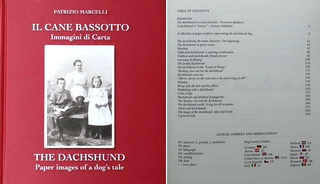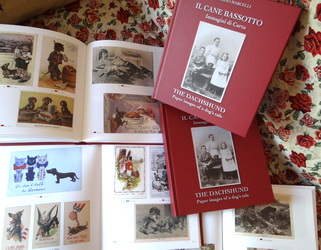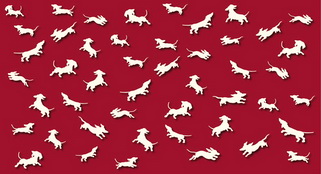Paper images of a dog's tale
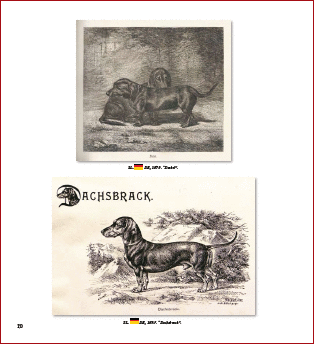 Paper has accompanied the life of man in the spread of ideas and images for the last several centuries, contributing to the historical memory of civilization.
Paper artifacts brilliantly overcame the abuses of time in the same way or better than other precious and refined materials, despite their fragile and short-lived nature.
Paper does not have the same three-dimensionality and solidity of clay, stone or metal; neither does it have the transparency of glass or the warmth or aging of wood, it is a poor material. It is mainly appreciated through the eyes and less so through touch.
Nevertheless, some characteristics make it unique: it is not bulky or cumbersome, it is easy to store and collect.
The invention of print, in the 1800s, led paper to achieve its highest degree of expression and mass usage.
Today’s print process, has remarkably improved paper’s access, for research on a global scale.
This book of images is a selection of paper artifacts where the dachshund is the main character.
It is a collection that comes back to be shared in a paper format, for its second life.
The book component is more intimate than our computers, to which we assign memories to images far too easily.
The book starts in the 1800s, with the dachshund’s first steps from Austria and Southern Germany towards the rest of the world.
The dachshund has been regarded as one of the most popular and loved companion animal in the world for its versatility and phenotype. It continues to hold that status today.
The first draft on the breed’s standards and the first studbook included 54 dogs and was published in Germany in 1879. The DTK (Deutscher Teckel Club), the German Teckel Club, founded in 1888, started in 1890 the publishing of the “Teckel Stammbuch”, the book of origin, which displayed technical drawings and pictures of proclaimed champions of their breed.
The book you are about to read, on the other hand, does not emphasize the importance of the size, shape or attitude of the dog; nor does it touch the “beauty” or “manners” of a “show dog”.
The images included “go beyond” those values that distinguish the dachshund from the rest; they represent the life of its “associates” and followers.
Various artists, photographers, graphic designers, comic-strip writers and illustrators produced a vast array of iconography dedicated to this unique breed and the dachshund was dubbed with the title of mascot at the Olympic Games in 1972.
Paper has accompanied the life of man in the spread of ideas and images for the last several centuries, contributing to the historical memory of civilization.
Paper artifacts brilliantly overcame the abuses of time in the same way or better than other precious and refined materials, despite their fragile and short-lived nature.
Paper does not have the same three-dimensionality and solidity of clay, stone or metal; neither does it have the transparency of glass or the warmth or aging of wood, it is a poor material. It is mainly appreciated through the eyes and less so through touch.
Nevertheless, some characteristics make it unique: it is not bulky or cumbersome, it is easy to store and collect.
The invention of print, in the 1800s, led paper to achieve its highest degree of expression and mass usage.
Today’s print process, has remarkably improved paper’s access, for research on a global scale.
This book of images is a selection of paper artifacts where the dachshund is the main character.
It is a collection that comes back to be shared in a paper format, for its second life.
The book component is more intimate than our computers, to which we assign memories to images far too easily.
The book starts in the 1800s, with the dachshund’s first steps from Austria and Southern Germany towards the rest of the world.
The dachshund has been regarded as one of the most popular and loved companion animal in the world for its versatility and phenotype. It continues to hold that status today.
The first draft on the breed’s standards and the first studbook included 54 dogs and was published in Germany in 1879. The DTK (Deutscher Teckel Club), the German Teckel Club, founded in 1888, started in 1890 the publishing of the “Teckel Stammbuch”, the book of origin, which displayed technical drawings and pictures of proclaimed champions of their breed.
The book you are about to read, on the other hand, does not emphasize the importance of the size, shape or attitude of the dog; nor does it touch the “beauty” or “manners” of a “show dog”.
The images included “go beyond” those values that distinguish the dachshund from the rest; they represent the life of its “associates” and followers.
Various artists, photographers, graphic designers, comic-strip writers and illustrators produced a vast array of iconography dedicated to this unique breed and the dachshund was dubbed with the title of mascot at the Olympic Games in 1972.
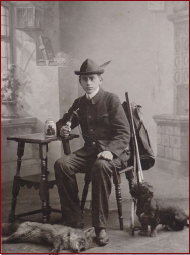 The invention of the postcard emerged simultaneously with the beginning of dachshund history. A wide array of the selection shown is represented by postcards in a chronological sequence.
For many decades the use of this communication has been popular at a worldwide level. This is proven time and time again with the varying number of languages seen on the backside of the postcards.
This book is structured in themes and chapters, composed of pictures. It starts with a series of the oldest portraits of dachshunds. It continues with chapters illustrating those dogs in the environment where they have been bred and scenes while hunting, highlighting their voracity. Playful moments with children are also shown, highlighting their loving disposition. From those and other situations, the central theme of the paper story unravels until the 1970s.
The “reading” of the presented images can be done in multiple ways: from a technical, historical, artistic, graphical, emotional, sociological, psychological, comic or lifestyle perspective.
Where possible, the images have been dated together with their place of publishing, author and editor.
Germany and Austria have produced most of the various documents collected in this book but there are other evidences from England, United States of America, France, Italy, Belgium, Holland, Czech Republic, Slovenia, Japan, Russia and other nations.
The invention of the postcard emerged simultaneously with the beginning of dachshund history. A wide array of the selection shown is represented by postcards in a chronological sequence.
For many decades the use of this communication has been popular at a worldwide level. This is proven time and time again with the varying number of languages seen on the backside of the postcards.
This book is structured in themes and chapters, composed of pictures. It starts with a series of the oldest portraits of dachshunds. It continues with chapters illustrating those dogs in the environment where they have been bred and scenes while hunting, highlighting their voracity. Playful moments with children are also shown, highlighting their loving disposition. From those and other situations, the central theme of the paper story unravels until the 1970s.
The “reading” of the presented images can be done in multiple ways: from a technical, historical, artistic, graphical, emotional, sociological, psychological, comic or lifestyle perspective.
Where possible, the images have been dated together with their place of publishing, author and editor.
Germany and Austria have produced most of the various documents collected in this book but there are other evidences from England, United States of America, France, Italy, Belgium, Holland, Czech Republic, Slovenia, Japan, Russia and other nations.
